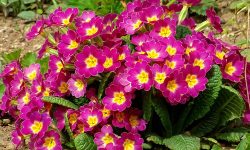Orchids are one of the most diverse and widespread plant families in the world. They can be found on every continent except Antarctica, and in almost every type of habitat. Orchids have even adapted to life in the rainforest canopy, where they receive little light and must compete for space with other plants.
Despite their diversity, all orchids share some common features. They are all epiphytic, meaning that they grow on other plants or objects rather than in soil. Most orchids have thin, leathery leaves that absorb water and nutrients from the air.
And of course, all orchids are famous for their beautiful flowers.
The tropical rainforest is a hot, wet environment that is home to many different types of plants and animals. Orchids have adapted to this environment in several ways.
First of all, they have developed special roots that can absorb water from the misty air. They also often grow on other plants, using them for support while still getting enough light to photosynthesize. Finally, many rainforest orchids have large flowers with bright colors that attract pollinators like bees and butterflies.
The tropical rainforest is one of the most diverse ecosystems in the world. Orchids are a large group of plants that have adapted to this environment and can be found growing in the trees, on the ground, and even epiphytic (on other plants). They have evolved to take advantage of the many different niches available in the rainforest.
One way that orchids have adapted to the rainforest is by developing aerial roots. These roots help them to attach themselves to tree trunks and branches, which gives them access to sunlight and allows them to grow above the ground where they would otherwise be competing with other plants for space. The aerial roots also absorb moisture from the air, which is important in an environment where it rains frequently.
Orchids have also adapted to the shady conditions of the rainforest by having leaves that are very thin. This allows them to absorb more light than thicker-leaved plants. In addition, many orchids have white or pale-colored flowers.
This reflects more light than darker colors and helps these flowers stand out in dimly-lit forest habitats.
The vast majority of orchids are pollinated by insects, although there are a few that rely on bats or birds for pollination services. Insects are attracted to brightly-colored flowers with conspicuous patterns, which makes it easy for them to find these flowers and transfer pollen between them as they feed.
Some orchids even produce scents that mimic those of rotting flesh or decaying vegetation, which attract flies and beetles that would normally not visit flowers at all!
Orchids are a fascinating group of plants that have adapted in many ways to life in the tropical rainforest. Their ability to thrive in such a diverse and challenging environment is a testament to their evolutionary success.
How Do Ferns Adapt to the Tropical Rainforest
Ferns have long been a part of the tropical rainforest ecosystem and are an important part of the food chain. They have adapted to the warm, humid environment and the lack of sunlight by developing large leaves that can capture light from the forest canopy. Ferns also have a deep root system that helps them absorb water and nutrients from the soil.
How Do Bromeliads Adapt to the Tropical Rainforest
Bromeliads are a type of plant that is native to the tropical rainforest. They have adapted to this environment in a number of ways. For example, they have large leaves that act as umbrellas, allowing them to capture rainfall and store it in their leaf bases.
This water helps to keep the plants moist during dry periods. Bromeliads also have roots that help to anchor them in place and absorb nutrients from the forest floor.
The tropical rainforest is a hot, humid environment that receives a lot of rainfall each year.
Bromeliads have adapted to this climate by developing thick leaves that can withstand high levels of humidity and strong winds. The leaves of bromeliads are also covered with wax, which helps to protect them from excessive moisture and prevent fungal growth.
Orchids in the Tropical Rainforest
Orchids are one of the most diverse and widespread families of flowering plants in the world. They can be found on every continent except Antarctica, and in almost every habitat imaginable from hot, dry deserts to cold, wet rainforests. Orchids have even been found growing on the carcasses of animals!
There are over 25,000 different species of orchids, making them one of the largest plant families in existence. The vast majority of these species (around 22,000) are found in the tropical rainforests of Central and South America, Africa, and Southeast Asia.
Orchids come in a huge variety of shapes and sizes, but they all have one thing in common: their flowers have evolved to attract pollinators such as bees, butterflies, moths, and even bats!
The flowers are often brightly colored and fragrant, which helps to lure in potential pollinators. Some orchid species have even evolved to mimic the appearance of female insects in order to trick males into trying to mate with them!
Orchids play an important role in the rainforest ecosystem by providing food and shelter for many animals.
The large leaves of some species make excellent homes for frogs, lizards, and other small creatures. And the nectar-rich flowers provide a vital source of food for many birds, bats, and insects.
So next time you see an orchid growing in a rainforest (or anywhere else!), take a moment to appreciate this amazing plant family that has truly conquered the world!
How Do Philodendrons Adapt to the Tropical Rainforest
Philodendrons are native to the tropical rainforests of South America. They are adapted to these conditions in a number of ways.
The leaves of philodendrons are large and often have deep lobes.
This allows them to maximize their surface area, which is important for photosynthesis. The leaf surfaces are also covered in a waxy substance, which helps to protect them from excessive moisture and humidity.
The stems of philodendrons are also thick and fleshy, which helps them to store water.
This is important in the tropical rainforest where water is often scarce. The roots of philodendrons are typically shallow, but they can be very long in order to reach any available moisture.
Philodendrons also have special adaptations that help them climb trees.
Their leaves often have aerial roots that help anchor them into bark crevices. They also produce small sucker-like structures on their stems, which grip onto tree trunks as they climb.
How Do Orchids Survive in the Rainforest
Orchids are one of the most popular flowers in the world, and they come in a wide variety of colors, shapes, and sizes. But how do these delicate flowers survive in the harsh conditions of the rainforest?
First of all, it’s important to note that not all orchids are found in the rainforest.
In fact, there are over 25,000 different species of orchids, and they can be found on every continent except Antarctica. However, a large majority of orchid species are found in tropical regions like the rainforest.
So how do these tropical orchids survive in such a hot and humid environment?
One key adaptation is their roots. Most orchids have aerial roots that absorb water and nutrients from the air around them. This helps them to avoid getting waterlogged when it rains heavily.
Another adaptation that helps orchids survive in the rainforest is their leaves. Orchid leaves are often very thin and covered with tiny pores called stomata. These stomata allow the leaves to take in carbon dioxide for photosynthesis while also allowing excess water to evaporate out of the leaves (a process known as transpiration).
This helps to keep the plant from getting too wet and prevents fungal growth that could damage the leaves.
Of course, no discussion of orchid adaptations would be complete without mentioning their beautiful flowers. The vibrant colors and intricate patterns on orchid blossoms help them attract pollinators like bees and hummingbirds.
But these flowers also have another purpose: they protect the plant’s delicate reproductive parts from getting damaged by too much sun or moisture.
So next time you admire an orchid at your local florist shop, remember that these amazing plants have evolved some pretty incredible adaptations to survive in one of Earth’s harshest environments -the rainforest!

Credit: justagric.com
What Features Help an Orchid Survive?
Orchids are one of the most popular houseplants, and for good reason! They’re beautiful, they come in a wide variety of colors and shapes, and they can bloom for months at a time. But orchids can be finicky, and if you don’t know how to care for them properly, they can quickly start to decline.
In this article, we’ll go over some of the features that help an orchid survive, as well as some tips on how to keep your orchid healthy and blooming.
One of the most important things to remember about orchids is that they are epiphytes. This means that in their natural habitat, they grow on other plants or trees, often without any soil around them.
Because of this, it’s important to make sure that your orchid has plenty of space for its roots to breathe. If the potting mix around your orchid’s roots starts to break down and compact too much, it can cause the plant to suffocate and die.
Orchids also need bright but indirect light in order to thrive.
Too much direct sunlight can scorch the leaves, while not enough light will prevent the plant from blooming. If you notice that your orchid isn’t blooming as often as it used to, try moving it to a spot where it will get more light.
In terms of watering, again less is more when it comes to orchids.
Overwatering is one of the main reasons why these plants decline; too much water can lead to root rot which will kill the plant eventually. Let the potting mix dry out completely between waterings (about once a week), then water thoroughly until water runs out of the drainage holes at the bottom of the pot. Be sure not to let your Orchid sit in water – always empty out any excess after watering so that the plant doesn’t become waterlogged.
Fertilizing regularly will also help keep your Orchid healthy – use a balanced fertilizer (10-10-10) diluted by half every two weeks during active growth periods (spring and summer).
Do Orchids Live in the Rainforest?
Orchids are a beautiful and popular type of flower, but many people don’t know that they actually grow in the rainforest. That’s right – orchids can be found in tropical rainforests all around the world.
There are over 25,000 different species of orchids, and they come in all sorts of shapes and sizes.
Some orchids are huge, while others are tiny. And they come in every color imaginable – from bright pink to deep purple.
Orchids grow best in humid environments, which is why the rainforest is the perfect place for them.
In fact, many species of Orchids can only be found in the rainforest.
If you’re ever lucky enough to visit a rainforest, keep your eyes peeled for these stunning flowers. And if you can’t make it to the rainforest anytime soon, you can always enjoy Orchids at your local florist!
Are Orchids Adaptable?
Orchids are one of the most popular houseplants because they are so beautiful. But many people think that orchids are difficult to grow, when in reality they can be quite easy – as long as you know what to do! One of the reasons why orchids are often thought to be difficult is because they come from tropical rainforests, where the conditions are very different from our homes.
However, this doesn’t mean that orchids can’t adapt to life in a pot on your windowsill. In fact, many species of orchid will thrive in these conditions if you give them the right care.
When it comes to watering, for example, you should never let your orchid sit in water – this will cause the roots to rot.
Instead, water your plant thoroughly and then allow it to dry out completely before watering again. Some people like to use an ice cube tray to water their orchids, so that each plant gets just the right amount without over-watering.
Light is another important factor for ORCHIDS TO THRIVE IN THEIR POTTED ENVIRONMENT.
Most species prefer bright indirect light – too much direct sunlight can scorch their leaves. If you don’t have a spot with bright indirect light, you can try growing an Orchid under artificial lighting such as fluorescent bulbs placed about 12 inches above the plant. Just make sure not TO PLACE THEM TOO CLOSE TO THE BULBS AS THIS CAN ALSO CAUSE LEAF SCORCHING!
Finally, remember that Orchids need good air circulation around them in order to thrive. This means that placing them near an open window is a good idea (as long as it’s not too drafty). You can also help increase air circulation by using a small fan – just make sure it’s not blowing directly on the plants as this could damage their delicate leaves.
By following these simple tips, you’ll find that Orchids ARE QUITE EASY TO GROW INDOORS AND WILL REWARD YOU WITH THEIR BEAUTIFUL BLOOMS FOR YEARS TO COME!
Where Do Orchids Grow in the Rainforest?
Orchids are a type of flowering plant that can be found in a variety of habitats, including rainforests. In the rainforest, orchids typically grow on trees. They may also be found on rocks or in the ground.
Orchids have a wide range of colors and shapes. Some common colors include white, pink, purple, and yellow. The flowers often have interesting patterns as well.
There are over 25,000 different species of orchids. They can be found all over the world, but they are most commonly found in tropical regions like the rainforest.
Are Lilies also found in tropical rainforests?
Lilies have limited lilie tropical climate suitability, making their presence in tropical rainforests rare. These delicate flowers prefer temperate regions with cooler temperatures and moderate sunlight. While some lily species can adapt to different environments, they are typically not commonly found in tropical rainforests due to the heat and humidity.
Adaptations In Plants | What Is ADAPTATION? | The Dr Binocs Show | Peekaboo Kidz
Conclusion
Orchids are a beautiful and popular flower, but many people don’t know that they actually come from the tropical rainforest. Orchids have adapted to this environment in a few different ways. First of all, they have evolved to be epiphytes, which means that they grow on other plants or trees instead of in the ground.
This helps them to get the sunlight and air they need without being competing with other plants for resources. Additionally, orchids have developed specialised roots that can absorb water and nutrients from the air around them. Finally, most orchids are pollinated by insects instead of wind, which is more common in other types of flowers.
This allows them to stay still and not waste energy on producing pollen that will just blow away. All of these adaptations make it possible for orchids to thrive in the tropical rainforest despite its challenges.






